Indoor cypress: types and varieties, how to care for it?

Cypress is a plant that reminds of summer, sea, relaxation, fresh air. But this smell of freedom and good mood can be easily prolonged if you buy indoor cypress at home. But what kind and variety to choose and how to care for it? Let's try to figure it out.
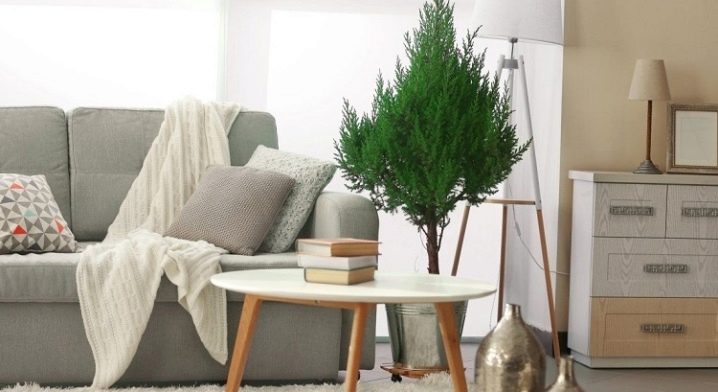
Peculiarities
The biological family Cypress includes more than 30 genera and more than 166 species. The most famous representatives of evergreen genera: juniper, thuja, tuyevik, cypress, cypress. Cypress (Cupréssus) and cypress (Chamaecýparis). These plants are very similar, hence the confusion among home growers in the names of their species and varieties.
Cypress trees - inhabitants of the tropics and subtropics... They appeared in the Cenozoic era, so it would be unfair to say that their homeland is the Mediterranean or North America: there were no such territories on the planet. But the plant feels comfortable there, as well as on the Black Sea coast, the Far East, the temperate zone of Asia, Australia.
In a cypress, both male and female cones (monoecious plant) grow under one crown. In the second year, the cones ripen: the seeds that hide under the scales force the capsule to open during its own growth. Inside each of the several seeds is an embryo from which a young plant with small, light green, soft, needle-shaped leaves can be grown. Over time, they will press against the branches, darken and resemble scales.
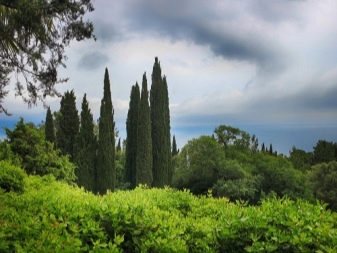

The cypress has flatter branches and soft cones, which ripen in a year and carry no more than 2 seeds in each scale (less than that of a cypress).
Comparing these trees by other parameters, we can cite the following facts: one of the tallest cypress trees - 38 meters, cypress trees - 81 meters. The age of the oldest cypress tree is about 120 years old, the cypress tree is about 5000 (!) Years old, that is, it is older than the first Egyptian pyramid. This cypress tree, which was named Methuselah by the park staff, grows in California. And it was there that they first began to grow homemade cypresses.
Like all conifers, cypress grows slowly, while they have excellent decorative properties and a pleasant aroma. Run your hand over the twigs of the plant and you will smell a slight lemon scent. Phytoncides clean the air not only from bacteria, but also save it from moths.
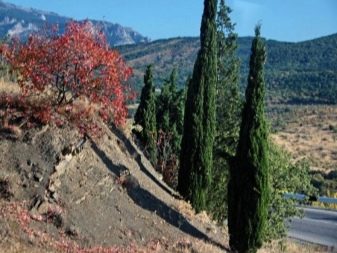
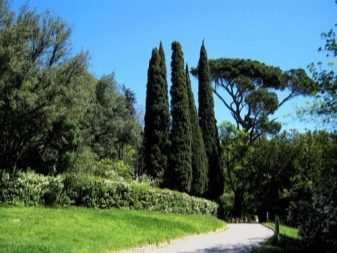
It has been proven that two trees, located on 10 square meters, reduce the number of pathogenic microorganisms in the air by 50-70%. It was these properties that made flower growers think: why not try to grow a small indoor cypress?
Types and varieties
At the moment, both cypresses and cypress trees are grown at home.
Cypress trees have few such species due to their large size.
- Evergreen (Cupressus sempervirens) - is a tree with branches pressed to the trunk and a pyramidal crown. It can reach a height of 2-3 meters, therefore it is often exhibited as a specimen in a winter garden, which is grown in a large tub. The trunk with brown-brown bark exfoliates in thin plates. Scaly dark green small leaves containing etheric glands adjoin the shoots closely. The most decorative are two varieties: in the horizontal, the main branches grow parallel to the ground, and from them young branches stretch upward, forming a crown in the form of a tent.The pyramidal look is prized for the soccer ball bumps, among other things.
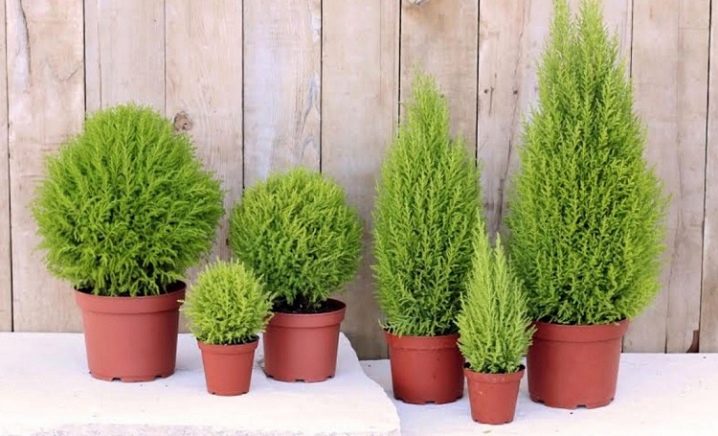
- Large-fruited (Cupressus macrocarpa) - one of the most popular types for home cultivation, which reaches 2 meters in height. Dark green lower branches in combination with light green upper branches give a special decorative effect. The dwarf variety "Goldcrest" has golden needles, for which it often plays the role of a New Year tree. Varieties from the Gold series are often called golden cypress for their color and lemon for their aroma. This species loves warmth, therefore, its pot is often made rolling so that it can be transported from home to the street. The species is named so for its large cones, which reach 38 mm.
Relatively recently, researchers became convinced that the plant is not a cypress, but represents another genus of cypress - hesperocyparis, that is, it is correct to call this species the large-fruited hesperocyparis (Hesperocyparis macrocarpa). But out of habit, we call the tree cypress.
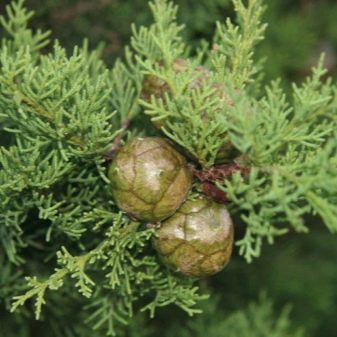
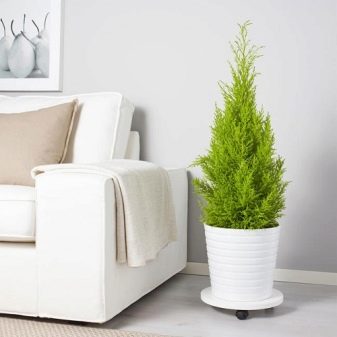
- Moroccan, aka Atlas cypress (Cupressus atlantica) - a beautiful and rare species, which is often grown outdoors, but growers are trying to grow it at home. It looks a lot like a green narrow spire that could very well become a Christmas tree.
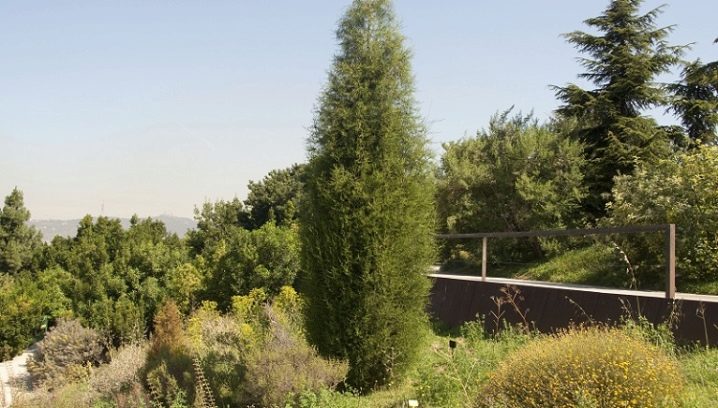
- Kashmiri (Cupressus Cachmeriana) - some gardeners are called the most adapted for growing at home, since he does not like low temperatures, and its dimensions are quite compact.

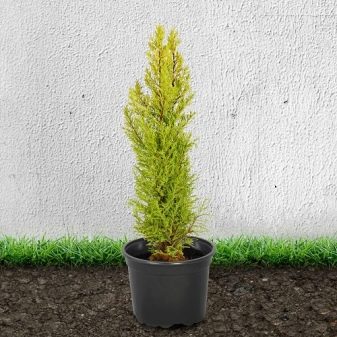
Cypress breeders bred much more for home cultivation. We will name several types that are most popular with flower growers:
- Pea: has horizontal branches and bluish-gray needles with yellow-brown cones.
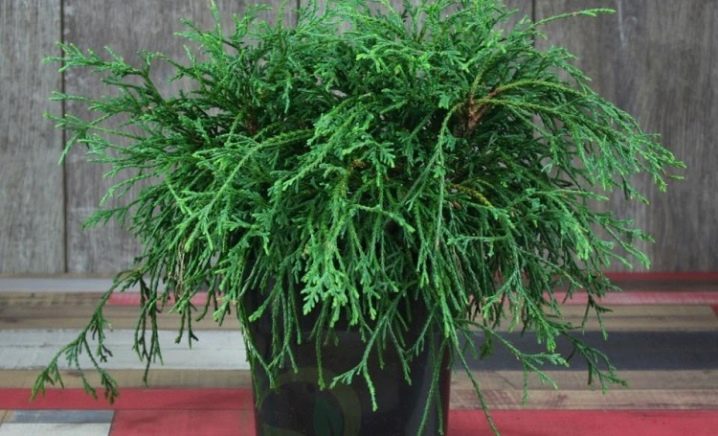
- Lawson's cypress: narrow cone with the tip strongly inclined to one side. The green needles on the upper side are smooth, pale brown cones cast blue.
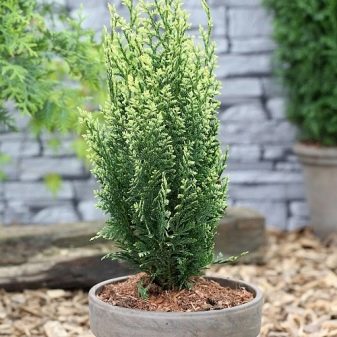
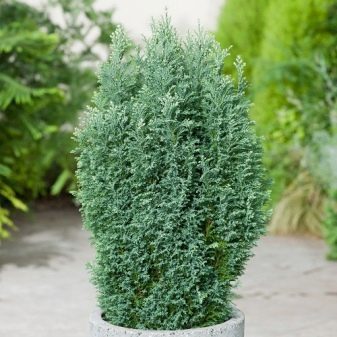
- Yellow cypress has a graceful lush crown with dark green needles. The bumps are like balls.

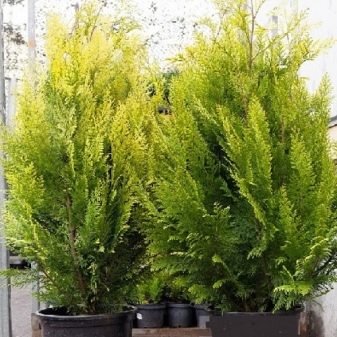
There is also a dull cypress, thuose, mourning, Formosian. And each of these species has several varieties. Thus, it turns out that in stores and in our houses you can often find not a cypress, but a cypress.
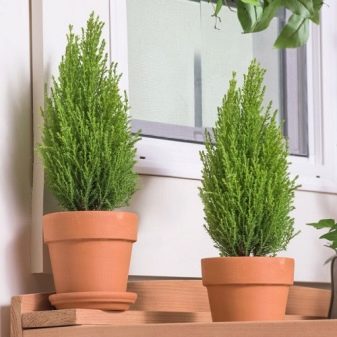
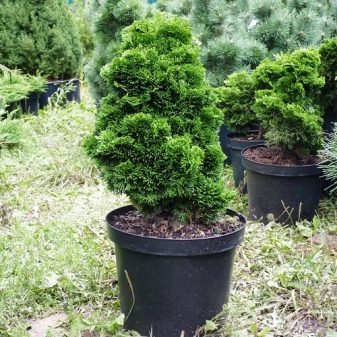
Care rules
Since the rules for caring for indoor cypress and cypress are very similar, then we will continue to talk in general terms about these representatives of the Cypress family.
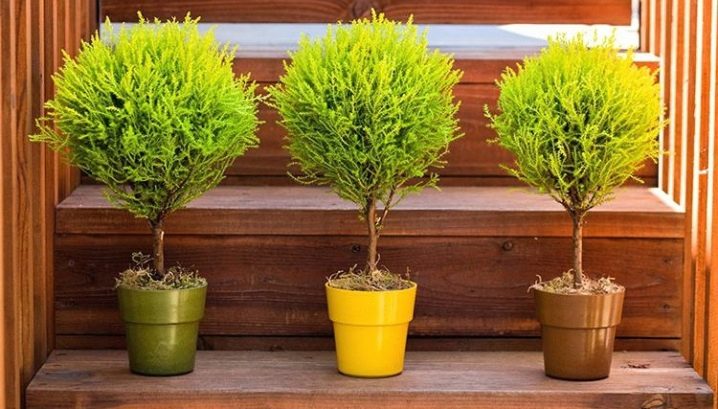
Lighting
The subtropical plant simply needs a lot of light, but at the same time, the young tree may not withstand direct sunlight. Therefore, it is better to place it on a shaded windowsill. If the windows face north or east, then there is no need to shade it. In winter, on the contrary, the plant should be placed as close as possible to the sun's rays. If the daylight hours are short or the weather is constantly cloudy, then it is necessary to turn on additional lighting, often phytolamps are used for this.
In the absence of a sufficient amount of light, any indoor flower stretches, becomes thinner, loses its shape and color. The same will happen with cypress.

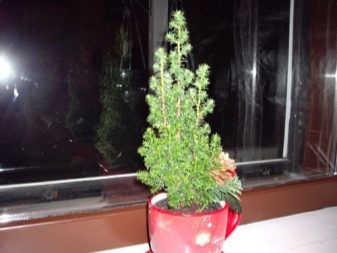
Temperature
When creating conditions close to natural, difficulties may arise, since cypress is a seasonal tree: in summer it is comfortable at a temperature of about 25 degrees Celsius, and in winter - about 10 degrees Celsius. Since it is problematic to create such conditions in an apartment, the pot is often taken out to the insulated balcony in winter. But to keep it until spring is likely the pot will have to be insulated, otherwise the earth in it will freeze along with the roots.
Cypress trees will not grow next to heating radiators, they do not like drafts, but they like fresh air.
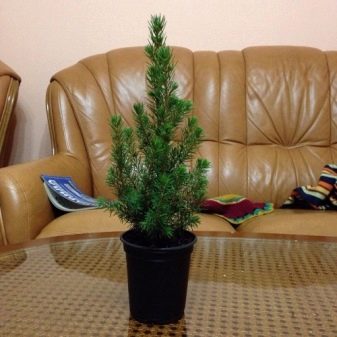
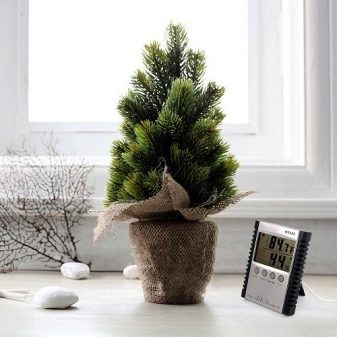
Moisturizing
Often when growing indoor flowers, flower growers irrigate different plants incorrectly, believing that since they grow in the same conditions, then they need to be watered in the same way. This is not true. For example, cypress loves water, but is bad for stagnant water in a pot. Therefore, the "flower" is watered often, but not abundantly.The frequency of watering depends on the ambient temperature: in the habitat of the plant +8 degrees, we water it once a decade; + 12-14 degrees - watering once a week, + 20-25 degrees - 2-3 times a week.
But at the same time, you need to keep an eye on the earthen lump all the time - it should always be moist. This is perhaps the main indicator of how often the plant needs to be watered. If the soil, standing on the windowsill above the heating radiator, is very dry, then the pot is lowered into a bucket or deep basin with settled water at room temperature and kept waiting for all the air bubbles to come out. The pot is removed from the bucket, the water is allowed to drain and the cypress is returned to its place.
But this is an emergency measure: excess moisture will lead to decay of the root system and fungal diseases.
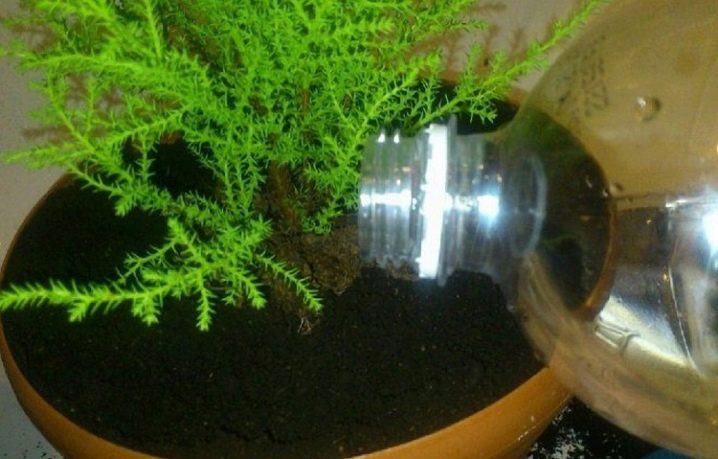
You can avoid waterlogging by spraying the twigs every day. Cypress will be grateful for such a procedure. Watering, spraying should not be done with running water. If it is chlorinated, it will harm the plant, if it is too hard, then a white bloom will appear on the needles and the ground. If it is not always possible to defend the water, then you need to keep anti-lime drugs at hand such as "PhytoKislink"... The same biofungicide will be a good prophylactic agent against fungal and bacterial diseases.
Another way to achieve subtropical conditions is to use a humidifier or place the pot on a tray of expanded clay poured with water. At high temperatures in the house, this will help not only the green inhabitants of the house, but also people and animals.
The main thing is not to forget that constant excessive humidification of the air is not always good for people.
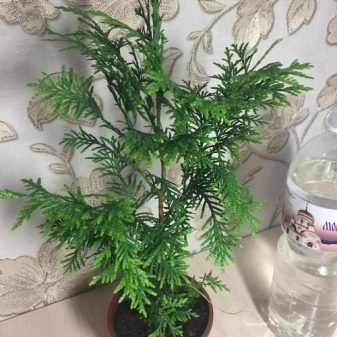
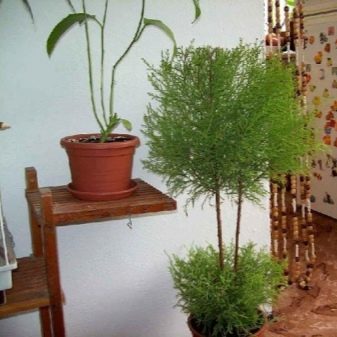
Soil loosening
During frequent watering, the soil is compressed and stops letting air to the roots. To avoid this situation, the soil is regularly loosened. Loosening is called dry irrigation. Usually this procedure is carried out as follows: watered today, poured tomorrow without watering. For loosening, use a small rake or fork.
You need to work very carefully so as not to damage the roots.
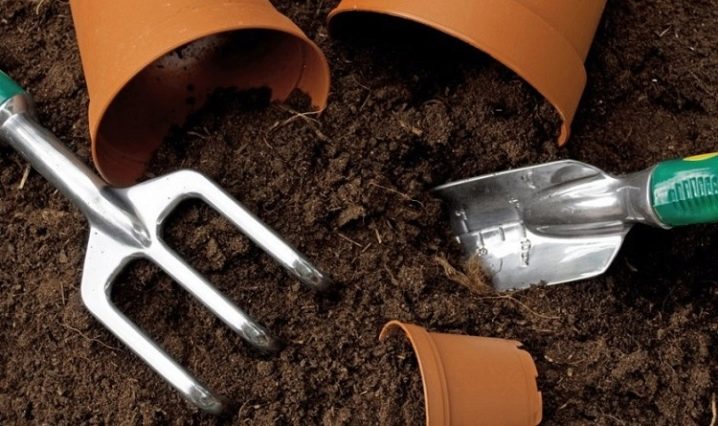
Top dressing
When growing cypress houses, top dressing pursues the main goal of preserving and improving the appearance of the crown, as well as maintaining the optimal size of the home tree. Indoor cypress refers to plants with the need for rest in the winter. This means that usually no feeding is carried out in the autumn-winter period, otherwise it will provoke growth and worsen wintering. What cypress loves and what it needs:
- magnesium for the formation of chlorophyll;
- calcium for young shoots;
- sulfur, iron and other trace elements, except chlorine;
- stimulants to relieve stress after winter and in the off-season.
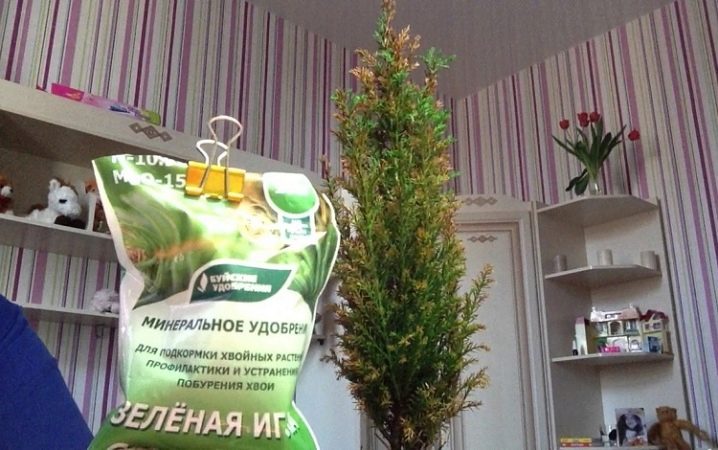
Professionals warn that conifers categorically do not need to give "fast" nitrogen fertilizers - complexes, as well as manure, bird droppings, herbal infusion, since when planting in turf and humus there is a sufficient amount of nitrogen, potassium and phosphorus. The seasonal feeding scheme looks like this:
- in spring the plant is sprayed at the same time Ferovit and watered "Zircon" or their analogues;
- from spring to late summer, once a month, complexes such as Pokon, Florovit, Green Needle;
- spring bedding or watering potassium-magnesium preparations;
- during the warm season, twice a month, it is sprayed or watered with fertilizers such as Agricola, Fertika Leto, Zdraven, but it is recommended to dilute them in half the dose of that indicated in the instructions.
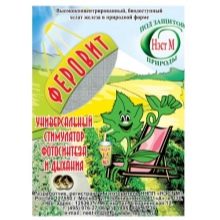


There are a few more recommendations for fertilization:
- it is convenient to add dry granules during transplanting, thoroughly mixing them with the soil;
- after transplantation (including after purchase), liquid fertilizers are applied no earlier than after 1-1.5 months;
- if pests or fungus are hung on the plant, then feeding is not carried out.
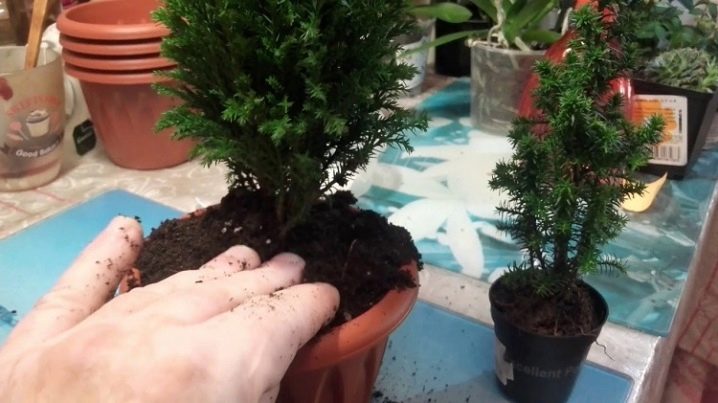
Pruning
No matter how slowly cypress trees grow, their sizes are still increasing.And if you do not make timely pruning, then soon the indoor tree will have to be planted outside. In the shape of the crown, cypresses are pyramidal and spreading. Depending on this, they give a decorative effect to the tree. Cropping can be:
- formative;
- curly;
- to keep fit.
Home varieties have a lighter crown, and there are also golden-yellow, bluish-green soft twigs. Thanks to these features, it is possible to form a topiary at home - to cut figurative trees. But if you do not want the plants to grow strongly upward, then when transplanting, you need to cut the roots and remove the excess branches completely, and not partially.
Pruning is carried out in the spring, but every month and a half the shape is adjusted. Old shoots are removed, young ones are slightly shortened. No more than 1/3 of the greenery can be removed in one cut. The first pruning for crown formation is carried out no earlier than a year after planting. During the procedure, the room is filled with lemon aroma and phytoncides.
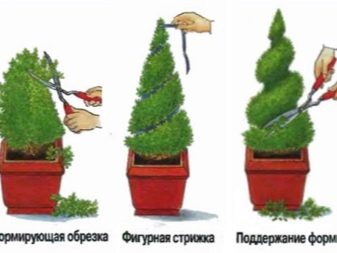
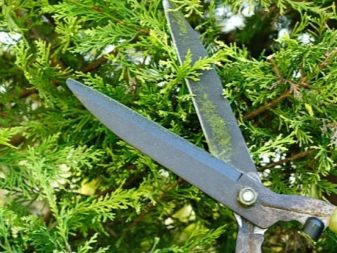
Transfer after purchase
Whether it is necessary to transplant the plant immediately after purchase depends on what exactly was bought: a houseplant in a regular store peat mixture or a "Christmas tree". Cypresses and cypress trees are very often used as a New Year's tree. In this case, they are often sold in large pots that do not require immediate replanting. Therefore, they may need the next transplant only after a year. But in any case, you should clarify the composition of the soil when buying a tree.
Conifers are hardy trees, so it makes sense to give the plant time to adapt after buying it in a temporary pot, and only then replant it. You can hear different information about how to do this better:
- there are experts who believe that you need to very carefully get rid of the storey soil by washing the roots of the plant;
- other growers argue that since the root system of the cypress is very capricious, even after the purchase, it must be transplanted by the transshipment method, that is, with an earthen lump;
- but if the tree was sprayed with silvery decorative snow as a New Year tree, then it must be washed off as quickly as possible - this is to save the pseudo-tree from death.
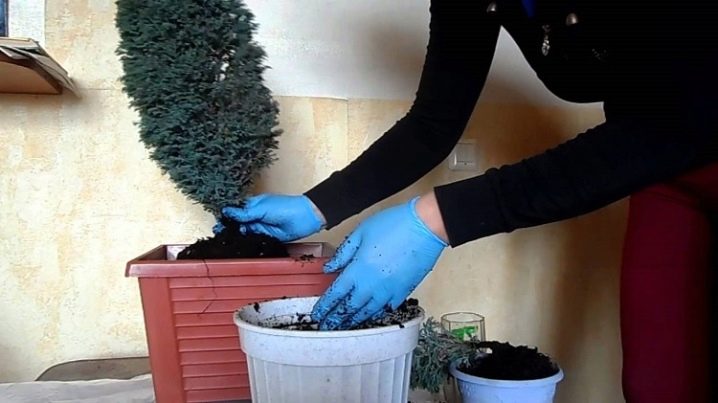
The same applies to the selection of soil: for cypress, the correct selection of soil acidity is very important, and you can be sure of its correct level if you use purchased soil for conifers or cypresses. Some professionals say that mixing the soil for cypress trees yourself is not a good idea. A mixture with a predominance of sod land is considered optimal. Peat, leafy earth, sand are welcome. If experienced florists nevertheless decide to prepare the soil mixture themselves, then they use the following options:
- 2 parts of turf + 1 part of leaf and coniferous soil + 1 part of coarse sand;
- 4 parts of turf + 2 parts of leafy soil + 1 part of sand;
- 1 part sand + 1 part peat + 1 part turf + 2 parts leaf or garden soil.
It is also important in which pot you plan to transplant the tree. Natural materials such as clay or wood are best suited. The roots breathe in them, and in winter there are more chances that the root system will not freeze on the balcony. The height of the pot should be about twice the width. The first pot after purchase should be about 5 cm larger than the store one.
They do the same thing further if they want the tree to grow.
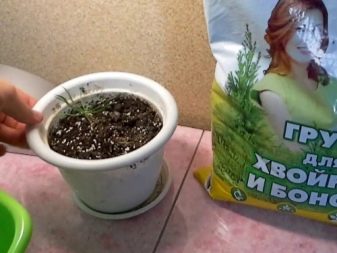
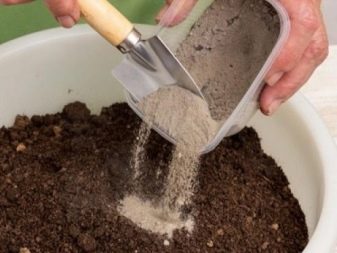
To plant a tree in a new pot, follow these steps.
- Fill the bottom of the container with a drainage layer: the larger the cypress, the harder the drainage should be (pebbles, expanded clay, broken ceramic shards, red brick and even a layer of sand for the stability of the container). The drain can take up 1⁄4 of the container.
- Spread a layer of soil mixture.
- If the option with flushing the root system is chosen, then the roots are neatly laid out on the earth layer.If the transfer method is used, then the earthen ball is placed in the pot.
- From above and from the sides, the roots are covered with earth so that the root collar is above the ground or at the level of the soil.
- Moisten the soil.
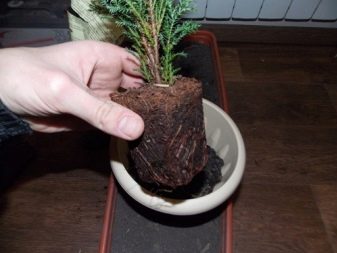
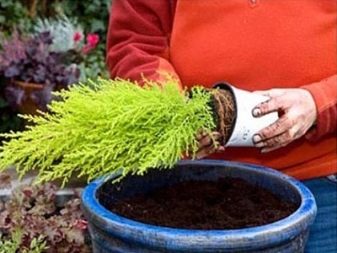
In what other cases is cypress transplanted:
- when the root system has grown so much that there is practically no earth left, and the roots have broken through the drainage holes;
- when there is a fear that the tree may fall because of the large crown;
- when the plant got sick: the earth became acidic, a spider mite or fungus started up.
The transplant is carried out in several ways:
- complete - with the removal of all the old soil from the root system, it is carried out with a cypress disease or bonsai cultivation.
- partial - transshipment with an earthen clod from the previous pot with or without root cutting;
- replacement of the top layer of soil without replacing the pot - when the tree is too large to transplant.
How often cypress trees need to be replanted depends on the size of the bush and pot. It is usually advised to replant the young tree once a year.
After reaching the age of three, it is recommended to transplant only when necessary, so as not to disturb the delicate roots of the cypress.


Reproduction methods
Cypress can be propagated either by seeds or by cuttings. Each grower chooses a method according to his skills, but you can also try to use both methods at the same time, and then compare them.
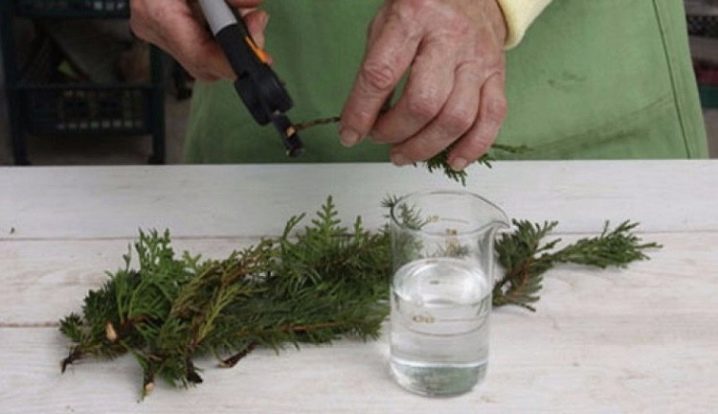
Seed method (used in the second half of spring).
- A ripe cone is the one that has opened, but inside it has a greenish color. Seeds are poured from under the scales and sent to the refrigerator for cold treatment (stratification) for 90-120 days. If the seeds are not shaken out, the cone can be dried on the battery.
- Any biostimulant ("Zircon", "Epin", "Kornevin", "Heteroauxin", "Athlete") is diluted in a non-food container and the seeds are soaked in it for 12 hours.
- Crushed bark is poured into the boxes as drainage, and on top is a soil mixture for conifers. The soil is moistened.
- The seeds are planted according to the 4 cm * 4 cm scheme and covered with about 1 cm of earth.
- The boxes are placed in a warm place and the soil is regularly moistened.
- Seedlings should appear in about 3-4 weeks. Experts say that about half of the seeds will sprout.
- Seedlings really need a lot of diffused light. They are recommended to be tempered by taking them to the balcony.
- A pick into individual pots is carried out when they reach a height of 5-6 cm.

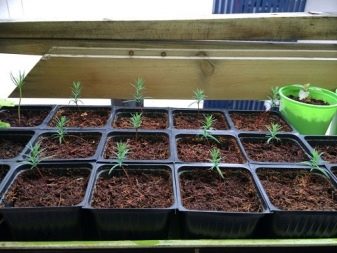
Cutting is best done in April, so that the seedling has time to take root and grow stronger in the warm season during the active growing season.
- Cuttings are usually harvested during pruning. Use the tops or semi-lignified cuttings. Cut the branches with a knife, not with scissors, so as not to crush the stalk.
- The lower part of the cuttings is cleaned of scaly leaves and immersed in a biostimulant solution for a day.
- Before planting, the cut site is sprinkled with crushed charcoal or activated carbon for disinfection.
- The cutting is lowered into the prepared soil by a third and slightly dripped.
- Moisten the soil.
- A polyethylene or glass cap (bag, jar, bottle) is erected over the pot (box). Such a greenhouse is ventilated so that a lot of condensation does not form there, once every 1-2 weeks.
- It is assumed that the cuttings will take about 2 months to take root.
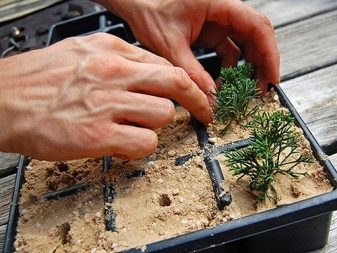
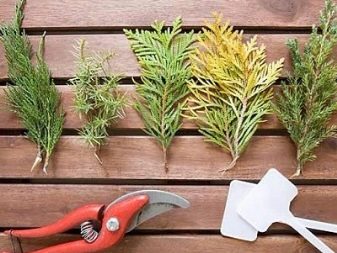
Diseases and pests
For cypress, it is important that the water does not stand in the pot, otherwise root rot may appear on the roots. Then the diseased specimen will have to be transplanted into new soil and a pot, cutting off the infected roots. But excessive dryness of the earth and air will lead to the appearance spider mite. If the tree is poorly looked after, then at first it will be seen that it is drying, and only upon closer examination will the cobweb be visible, which has entangled not only the foliage, but also the roots.
Another pest - scabbardthat looks like oval plaques on twigs. It sucks nutrients from the plant, after which it dries. Aphid - a very popular and active pest, but in the event that the cypress is on the street.
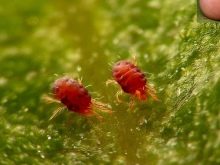

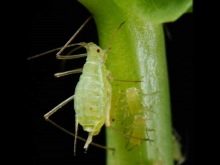
Fight all insects the easiest way is to use industrial insecticides ("Akarin", "Arrivo", "Antiklesh", "Confidor Extra"). It is highly likely that one treatment will not be enough. As a preventive measure, they help well spraying with soapy water.
And so that the cypress does not dry out, it is important not to forget to constantly moisturize the tree and the air around it.
If the leaves still turn yellow, then you can try to find a new place for the plant and feed it.
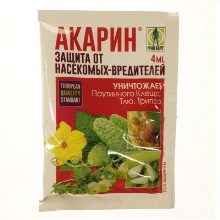
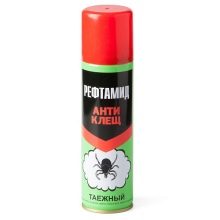
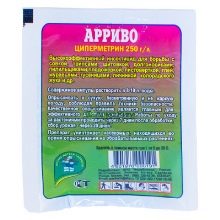
You can learn how to care for indoor cypress in the following video.




























































The comment was sent successfully.